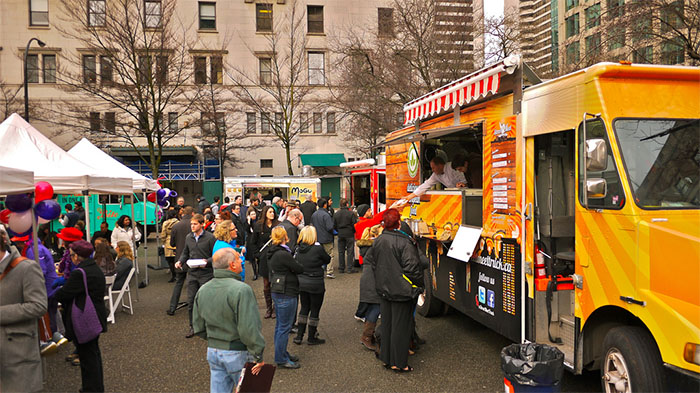Waiting in line is a universally despised experience; Americans spend about 7 years of their lives waiting in lines. With that said, waiting in line for gourmet food is something most of us who have visited a food truck event have had to learn to deal with.
Waiting In Line At Food Trucks
Understanding the psychology of waiting in line is a topic which is studied by industries that have constant lines of customers. In their research scientists have found some very interesting factors that make waits seem longer…
- Unoccupied time feels longer than occupied time. When you have something to distract yourself, time passes more quickly. Distractions, such as TVs and smartphones, shorten perception of time.
- People want to get started. This is why restaurants give you a menu while you wait, and why food truck owners should have a menu board that a large portion of their waiting customers can read while they are waiting.
- Anxiety makes waits seem longer. If you think you’ve chosen the slowest line, or you’re worried about getting one of the last items a truck has left in its inventory, the wait will seem longer.
- Uncertain waits are longer than known, finite waits. People wait more calmly when they’re told, “The line will move fast enough for you to order within thirty minutes” than when they’re told, “you should be able to order soon.” Without signs or staff telling your waiting customers the approximate wait time, people will overestimate it by 23 percent.
- Unexplained waits are longer than explained waits. We wait more patiently for the pizza guy when there’s a thunderstorm than when the sky is clear. Letting the customers in line know why there has been a delay (you had to make a new batch of a particular menu item) will ease their line waiting anxiety.
- Unfair waits are longer than equitable waits. People want their waits to be fair. The “FIFO” rule (first in, first out) is a great rule, when it works. But sometimes certain people need attention more urgently. Then it gets trickier. Often, when people are treated out of sequence, it’s helpful to have them served from the other side of the truck or cart (i.e. someone who has called their order in).
- Solo waits feel longer than group waits. The more people engage with each other, the less they notice the wait time. In fact, in some situations, waiting in line is part of the experience.
According to MIT queueing theorist Richard Larson, “There’s no such thing as the perfect line, the trick is to convince people they’re being treated fairly.” We hope that this article helps both the food truck owners in understanding the frustration their customers are feeling while waiting in line for their food, and for those same customers to help themselves learn how to ease the pain that waiting in line at a food truck can cause.
The best tip we can give those who hate to wait in line but want to eat from a popular food truck is to be patient. Once you have received your meal, you will forget completely about your wait, and will be willing to jump back in line just to get another chance to eat the fantastic gourmet food this mobile bistro serves. Facebook | Twitter




